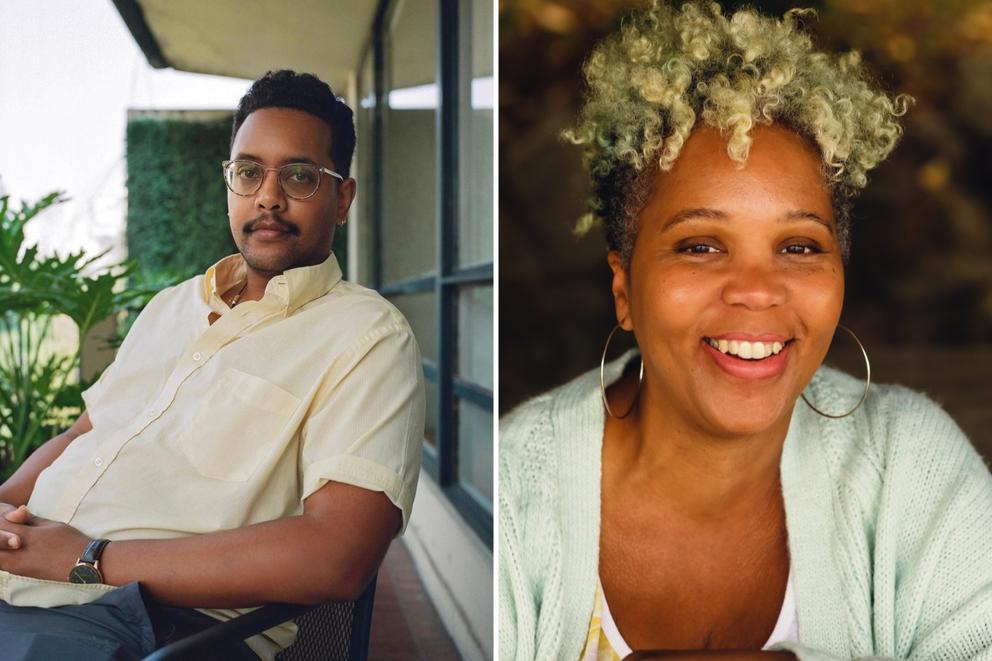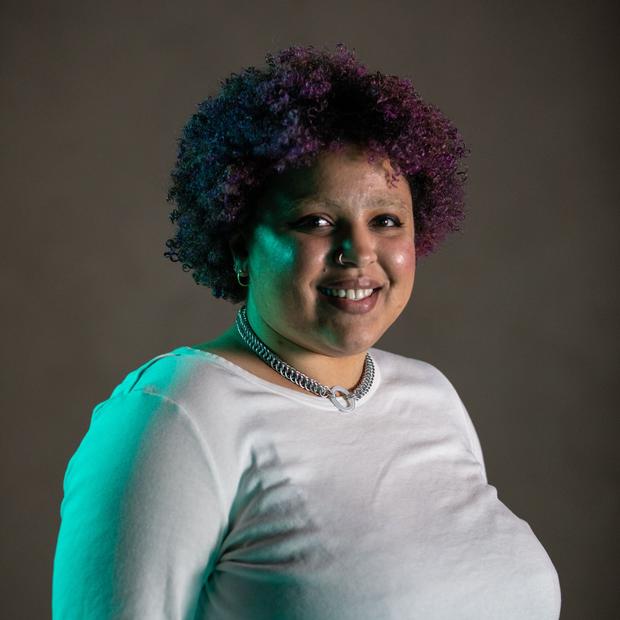Over the past several weeks, you’ve seen Meron’s photos alongside Jas Keimig’s profiles of cellist/composer Gretchen Yanover, painter/muralist Moses Sun and actor/director Tee Dennard, and his photos will continue to appear with this season’s remaining profiles. And, on Fridays, see the debut of Tifa’s five video episodes, such as videos on dancer Cipher Goings and longtime DJ Riz Rollins, airing and streaming on KCTS 9.
We’re going behind the scenes with Jas to talk with Tifa and Meron and get a look at Season 3 from their illuminating perspectives.
Meron Menghistab on the evolving aesthetic of his BAL photos
For the past three seasons of Black Arts Legacies, photographer Meron Menghistab has crafted beautiful images to accompany each profile.
Over the years, Meron has experimented with the aesthetic of these portraits. In Season 1, he placed gray backdrops in each artist’s home or studio as a way to frame them in a personal place; in Season 2, he projected images of each artist’s work all around them in a studio setting, in tribute to their careers. And this year, he decided to use film photography to capture every subject in their home environment, a nod to BAL’s archival mission.
“My outlook is always thinking about not only the literal sense of archiving artists in Seattle, but how I can make images that are a tribute to the idea of the archival process as well,” he says.
Approaching each photo session, Meron likes to keep it loose and get to know the artist so that he can best capture their personality and the spirit of their work. With cellist Gretchen Yanover, he bottled the intimate, reflective energy of her work and portrayed her playing at home, with her cat making a cameo appearance. And for Moses Sun’s portrait, he positioned the artist among many of his vibrant paintings in his carpeted studio.
“I try to spend a lot of time asking people, ‘Where do you tend to make work?’ or ‘Where do you spend your time in your space to make work?’” Meron says. “Some way to get them involved in how they wish to be represented.”
Behind the scenes: Reporter's Notebook
One of the best parts of working on Black Arts Legacies is being able to create work alongside Tifa Tomb, this project’s videographer. She’s been with BAL since the beginning, crafting excellent video profiles of our stellar subjects.
“The first year, I wasn’t really sure what to expect and how to structure the production of it all. So by this year, I’m a lot more confident in terms of getting the visuals that we need to tell the stories,” Tifa told me recently. “I just try to stay as curious as possible about what they have to say about their lives and their process.”
Even though our final written and filmed artist profiles are different, Tifa and I have similar processes for preparing: tons of background research. But for Tifa, there’s also a visual element.
“We talk [with the artist] about, like, OK, we’re coming to film the interview, but we also would like to get some view of you in your element, whatever that is. We just try to identify what their work is and how we could capture it visually,” Tifa says. “What can we see the person doing that will help tell the story of who they are?”
This year, I had the distinct pleasure of lurking behind the scenes with Tifa and her crew on a few video shoots — and it made me jealous. Writing can be such a solitary process, but when making a video, there are so many more people to talk to and run ideas past. On one shoot for a not-yet-announced BAL artist, Tifa — along with director of photography Neftali Kirkland and gaffer Papa Ibrahima Diop — ran the shoot like a well-oiled machine, framing shots and capturing the essence of the artist with ease. A definite benefit to working with a team versus toiling in front of my computer at home, as I’m wont to do.
As a bonus, Tifa says the project brings her closer to the Black arts community and the city.
“I start to see people and know about other people’s shows because of artists that we’ve profiled, and so it feels like the dots are a lot closer and they connect a lot more,” she reflects.
Get more Black Arts Legacies
This newsletter features a new artist each week, along with additional stories, exclusive content and responses to reader questions.





